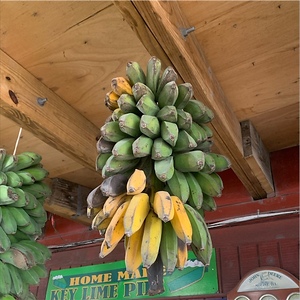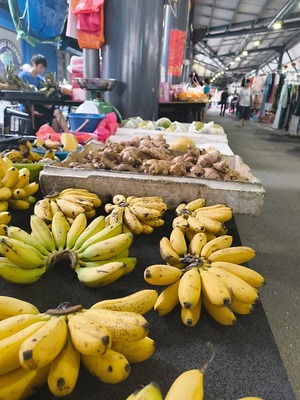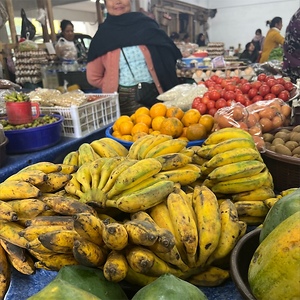


Baby Bananas
Estimated Inventory, 15 lbs : 3.41
This item was last sold on : 07/29/25
Description/Taste
Baby bananas are small fruits that grow in clustered bunches known as hands. Each hand typically contains 10 to 12 bananas, and the individual fruits are known as fingers, averaging 2 to 3 centimeters in diameter and 7 to 12 centimeters in length. The fruits generally have a straight, cylindrical shape with tapered ends and are short in nature. The peels are smooth, rubbery, and semi-thin, ripening from green to bright yellow, sometimes blushed with shades of pink. As the fruit matures, the peel will gradually develop tiny brown spots, often referred to as freckles. These freckles indicate ripeness and are created by the increasing presence of fructose in the fruit. Baby bananas are fragile, prone to bruising, and easy to peel, quickly revealing the edible portion of the fruit. The pale yellow to cream-colored flesh is smooth, dense, and seedless with a creamy, soft consistency. Baby bananas release a fruity aroma when peeled and have a rich, sugary, and sweet taste with vanilla, honey, and tropical nuances.
Seasons/Availability
Baby bananas are available year-round.
Current Facts
Baby bananas, botanically classified as Musa acuminata, are a category of dessert bananas belonging to the Musaceae family. The compact fruits are some of the smallest types of bananas found worldwide and grow on evergreen perennial plants reaching 4 to 7.5 meters in height, depending on if the plant is dwarf or standard. Baby bananas are a general descriptor for several varieties of small bananas cultivated worldwide, and the most prominent type is the Lady Finger banana. The petite fruits are also generally known as Mini bananas, Baby Nino bananas, Sugar bananas, Sucrier, Murapo, Date bananas, Finger bananas, Orito, and Fig bananas. Worldwide, Baby bananas have specific regional names, including Guineo Orito in Ecuador, Kluai Khai in Thailand, Pisang Emas and Pisang Mas in Malaysia, Cambures Titiaros in Venezuela, Amas in the Philippines, and Chuoi Trung in Vietnam. Baby bananas are valued for their small size, sweet taste, soft and creamy texture, and lack of discoloration when sliced. The bananas are commercially grown around the world and are sold through fresh markets, grocers, and distributors as a fresh eating variety. Baby bananas can also be utilized in cooked preparations and typically have a sweeter and creamier consistency than larger commercial Cavendish bananas.
Nutritional Value
Baby bananas are a source of fiber to stimulate the digestive tract, potassium to balance fluid levels within the body, and calcium to build strong bones and teeth. The bananas also provide copper to develop connective tissues, zinc to assist in repairing damaged tissues, vitamin C to strengthen the immune system, and other nutrients, including phosphorus, iron, and vitamins K, E, A, and B. Baby bananas are known for containing a high fructose content, a natural sugar digested in the liver to produce glucose, a monosaccharide sugar. Glucose is used in the body to make energy for muscles and organs.
Applications
Baby bananas have a sweet, subtly tropical, honey-like taste suited for fresh and cooked preparations. The bananas are favored for their small size and dense, creamy nature, allowing them to be consumed straight out of hand as a snack. Baby bananas are also slow to brown, popularly used in fruit salads, skewered fruit platters, parfaits, granola, porridge, and overnight oats. They can also be used as a fresh topping over pancakes, waffles, and French toast or layered on toast slathered in nut butter. Try dipping Baby bananas into melted chocolate and freeze as a healthy dessert. In addition to fresh preparations, Baby bananas can be baked into muffins, bread, blondies, bars, and cakes or added to puddings, pavlova, tiramisu, and other desserts. They can also be battered and fried, sauteed in caramel as a decadent sauce, or blended into ice cream, smoothies, and shakes. As an unusual twist on hot chocolate, Baby bananas can add a thicker texture, sweeter flavor, and frothiness to the drink. The fruits can also be incorporated into savory dishes, including curries and chicken dishes, or grilled for a smokey flavor. Baby bananas pair well with nuts such as pine, pecan, almonds, and walnuts, chocolate, vanilla, maple syrup, spices including cinnamon, ginger, nutmeg, and allspice, and fruits such as strawberries, raspberries, blueberries, coconut, mangoes, oranges, and passion fruit. Whole, unpeeled Baby bananas will keep for 1 to 2 weeks when stored at room temperature away from direct sunlight. Green bananas can be placed in a paper bag for faster ripening and held for 1 to 3 days to reach the desired maturity.
Ethnic/Cultural Info
Bananas are the national fruit of Cambodia. The fruits are prized among the Khmer people, one of the oldest ethnic groups in the country, and this group makes up over ninety percent of Cambodia's population. The Khmer value bananas for their widespread availability and versatility as a food, natural medicine, and spiritual offering. The banana selected as the Cambodian national fruit is a type of Baby banana known as Chek Pong Moan. This name is derived from Khmer, Cambodia's official language, and roughly translates to mean "chicken-egg banana." Chek Pong Moan bananas are primarily grown along the Mekong Delta, one of the longest rivers in the world, and are favored as a dessert banana, consumed in fresh and cooked preparations, especially desserts. Unripe Chek Pong Moan bananas are also cooked as a vegetable. Beyond culinary purposes, Chek Pong Moan bananas are grown as a source of income and are used as a natural medicine to reduce constipation and other digestive issues. The peels are also used topically on the skin to reduce swelling from rashes, bites, or wounds. Chek Pong Moan bananas were royally decreed the national fruit of Cambodia in 2005, but despite this relatively recent decree, the fruits have been treasured throughout Cambodia for centuries.
Geography/History
Baby bananas are descendants of wild banana varieties native to Southeast Asia. The wild bananas were selectively bred over time to create new types of bananas with improved textures, flavors, and appearances. While the wild fruits were being slowly domesticated, they were also being spread outside their native habitat through human migration and expansion in trade and exploration. Ancestors to Baby bananas were introduced to the New World in the 16th century by Spanish and Portuguese explorers, and the plants were further bred and domesticated throughout South and Central America. Today Baby bananas are cultivated worldwide and are popular fresh-eating fruits for their sweet taste and dense nature. Baby bananas thrive in warm, wet, tropical to subtropical climates with extended periods of sunlight. The fruits are traditionally sold in fresh markets and offered through grocers, distributors, and supermarkets. They are also grown in home gardens throughout Asia, Southeast Asia, the Pacific Islands, the Caribbean, tropical Africa, and Central and South America.
Featured Restaurants
Restaurants currently purchasing this product as an ingredient for their menu.
| Tahona (Kitchen) | San Diego CA | 619-573-0289 |
| Armonia LLC | San Diego CA | 619-724-7210 |
| Fresh Sushi Catering | Carlsbad CA | 858-344-7098 |
| My Chef | San Diego CA | 916-217-0049 |
| Cal A Vie | Vista CA | 760-945-2055 |
| Wildland | Carlsbad CA | 619-385-0914 |
Recipe Ideas
Recipes that include Baby Bananas. One
| Pinch of Yum |
|
Banana Lumpia Turon with Caramel Sauce |
| Cooking Channel |
|
Fried Baby Bananas with Coconut Cream |
| Weight Watchers |
|
Chocolate-Dipped Baby Bananas |
Podcast

















